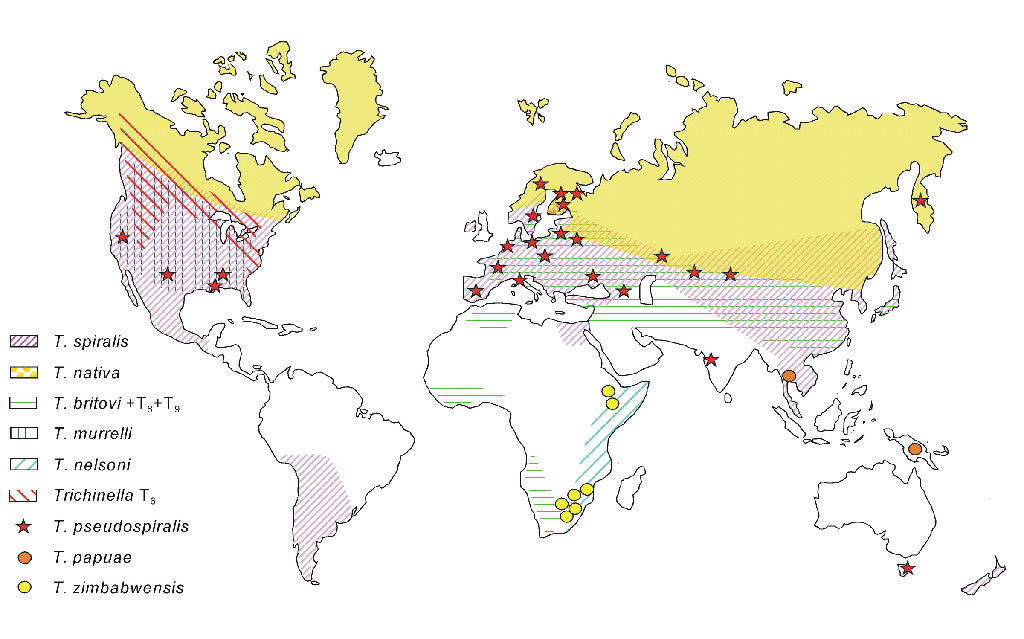Distribution & Transmiss

International Commission on Trichinellosis
Distribution and Transmission Patterns
Transmission patterns of Trichinella spp. may be grouped loosely into a domestic cycle and a sylvatic cycle (Figure 4). The domestic cycle involves primarily pigs and rats, while in the sylvatic cycle Trichinella spp. infection may be found in more than 100 species of mammals, as well as several species of birds (T. pseudospiralis) and reptiles (T. zimbabwensis and T. papuae). While T. spiralis is the most common species found in domestic pigs, T. britovi, T. murrelli, and all three non-encapsulating species have also been reported from domestic pigs. Other species (T. nativa, Trichinella T-6) have extremely low infectivity for pigs and are not considered a risk for transmission to domestic pigs.
The geographic distribution of the various species is only partially documented due to lack of research in some areas of the globe. It is known that T. spiralis is cosmopolitan and this species has been widely reported from North and South America, Europe and Asia, with localized reports from Africa (Egypt) and New Zealand. Other species have more restricted distribution, in some cases based on certain adaptations. The freeze resistant species (notably T. nativa and Trichinella T-6) are restricted to arctic and sub-arctic regions in the northern hemisphere and North America, respectively. T. britovi occurs in temperate regions of Europe and Asia and in western Africa, while T. murrelli occurs in temperate regions of North America. These species overlap in range with T. nativa and Trichinella T-6. T. nelsoni and Trichinella T-8 have only been reported from Africa, while Trichinella T-9 has only been reported from Japan. Among the non-encapsulating species, T. pseudospiralis is cosmopolitan in distribution, while T. papuae is currently only known from Papua New Guinea and T. zimbabwensis has only been reported in East Africa.

Transmission of Trichinella in the domestic cycles is primarily influenced by animal management practices involving pigs. Exposure of domestic pigs to Trichinella spp. is limited to a few possibilities including: 1) feeding of animal waste products or other feed contaminated with parasites; 2) exposure to rodents or other wildlife infected with Trichinella; or 3) cannibalism within an infected herd. The use of good production/management practices for swine husbandry will preclude most risks for exposure to Trichinella in the environment. Transmission of Trichinella in the sylvatic (wildlife) cycle relies on predation and carrion feeding. Generally, prevalence rates among carnivores increase up through the food chain. Sylvatic Trichinella infection affects public health in two ways. As a direct source, game meats pose a significant risk for human exposure to this parasite. Sources of documented human infection include wild boar, bear, walrus, fox, and cougar. Reducing exposure to Trichinella from these sources relies on education of hunters regarding the risks associated with eating raw or undercooked game meats. Sylvatic Trichinella infection also poses a risk as a source of infection to pigs. This is particularly true for Trichinella spiralis and other species/types which can infect pigs. Limiting contact of pigs with wildlife is part of an overall risk reduction program for control of Trichinella infection in the domestic pig cycle.
Further reading
Pozio, E. 2007. Taxonomy, biology and epidemiology of Trichinella parasites. In, (Dupouy-Camet, J and Murrell, K.D. eds.), FAO/WHO/OIE Guidelines for the Surveillance, Management, Prevention and Control of Trichinellosis, Rome, pp. 1-36.
International Trichinella Reference Center - http://www.iss.it/site/Trichinella/index.asp
Transmission patterns of Trichinella spp. may be grouped loosely into a domestic cycle and a sylvatic cycle (Figure 4). The domestic cycle involves primarily pigs and rats, while in the sylvatic cycle Trichinella spp. infection may be found in more than 100 species of mammals, as well as several species of birds (T. pseudospiralis) and reptiles (T. zimbabwensis and T. papuae). While T. spiralis is the most common species found in domestic pigs, T. britovi, T. murrelli, and all three non-encapsulating species have also been reported from domestic pigs. Other species (T. nativa, Trichinella T-6) have extremely low infectivity for pigs and are not considered a risk for transmission to domestic pigs.
The geographic distribution of the various species is only partially documented due to lack of research in some areas of the globe. It is known that T. spiralis is cosmopolitan and this species has been widely reported from North and South America, Europe and Asia, with localized reports from Africa (Egypt) and New Zealand. Other species have more restricted distribution, in some cases based on certain adaptations. The freeze resistant species (notably T. nativa and Trichinella T-6) are restricted to arctic and sub-arctic regions in the northern hemisphere and North America, respectively. T. britovi occurs in temperate regions of Europe and Asia and in western Africa, while T. murrelli occurs in temperate regions of North America. These species overlap in range with T. nativa and Trichinella T-6. T. nelsoni and Trichinella T-8 have only been reported from Africa, while Trichinella T-9 has only been reported from Japan. Among the non-encapsulating species, T. pseudospiralis is cosmopolitan in distribution, while T. papuae is currently only known from Papua New Guinea and T. zimbabwensis has only been reported in East Africa.

Transmission of Trichinella in the domestic cycles is primarily influenced by animal management practices involving pigs. Exposure of domestic pigs to Trichinella spp. is limited to a few possibilities including: 1) feeding of animal waste products or other feed contaminated with parasites; 2) exposure to rodents or other wildlife infected with Trichinella; or 3) cannibalism within an infected herd. The use of good production/management practices for swine husbandry will preclude most risks for exposure to Trichinella in the environment. Transmission of Trichinella in the sylvatic (wildlife) cycle relies on predation and carrion feeding. Generally, prevalence rates among carnivores increase up through the food chain. Sylvatic Trichinella infection affects public health in two ways. As a direct source, game meats pose a significant risk for human exposure to this parasite. Sources of documented human infection include wild boar, bear, walrus, fox, and cougar. Reducing exposure to Trichinella from these sources relies on education of hunters regarding the risks associated with eating raw or undercooked game meats. Sylvatic Trichinella infection also poses a risk as a source of infection to pigs. This is particularly true for Trichinella spiralis and other species/types which can infect pigs. Limiting contact of pigs with wildlife is part of an overall risk reduction program for control of Trichinella infection in the domestic pig cycle.
Further reading
Pozio, E. 2007. Taxonomy, biology and epidemiology of Trichinella parasites. In, (Dupouy-Camet, J and Murrell, K.D. eds.), FAO/WHO/OIE Guidelines for the Surveillance, Management, Prevention and Control of Trichinellosis, Rome, pp. 1-36.
International Trichinella Reference Center - http://www.iss.it/site/Trichinella/index.asp
